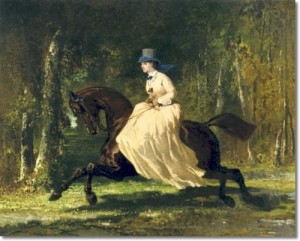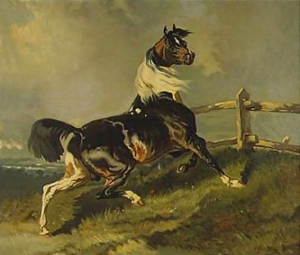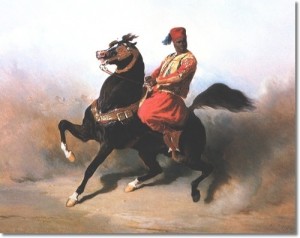For Thursday Art Day we re-visit ALFRED DE DREUX again!
Alfred-De-Dreux-une-amazone-en-foret
I know I blogged about Alfred De Dreux last week but I’m so very in love with his art, I couldn’t resist presenting more of his work. Arabian horse lovers will recognize some of his Arabian portraits but there are so many special paintings that it becomes hard to chose. His horses beauty, correctness and fluidness of form leaves me quite breathless
Alfred-De-Dreux-arabian-horse
His ladies riding side-saddle are some of the most romantic paintings one could hope to see. They make me long to ride beside them, beautifully dressed in a flowing riding habit and topper. I could write a story about each of them.
Alfred-de-Dreux skewbald stallion
The skewbald reminds you immediately of National Velvet with the image bringing The Pie to life. Do I dare to feature his side-saddle ladies next week? I guess it depends how much you all like his work. Again I hope you enjoy these paintings as much as I do…
Alfred-De-Dreux-an-african-groom-
ALFRED DE DREUX
1810 – Paris – 1860
Alfred de Dreux was born in France, the son of an architect. He first studied with Léon Cogniet and then entered the atelier of Eugène Isabey.
Alfred-De-Dreaux-cavalier-nubens
Throughout his career, however, de Dreux’s work was greatly influenced by Théodore Géricault (1791-1824), who was a close friend of his uncle, the painter Dedreux-Dorcey. Géricault painted de Dreux several times when he was a child. In 1831, de Dreux exhibited Interieur d’ecurie at the Paris Salon, which won him immediate fame. In 1840 he began his celebrated series of portraits of horses from the famous stables of the duc d’Orléans.
Alfred-de-Dreux-The-Pasha-s-Pride
Following the Revolution in 1848, the French royal family emigrated to England where de Dreux frequently visited them, painting many equestrian portraits of the exiled Emperor Napoleon III and his sons. He returned to France and was commissioned to paint a portrait of Napoleon III in 1859 (Musée de l’Armée, Paris). It was long rumoured that de Dreux was killed in a duel by Comte Fleury, Napoleon’s principal aide-de-camp, but Marie-Christine Renauld’s research has established that he died in Paris on 5th March 1860 from liver disease.
The work of Alfred de Dreux is represented in the Hermitage, St Petersburg; the Louvre, Paris; the Musée Camondo, Paris and museums in Bordeaux, Dijon and Chantilly.






Leave a Reply